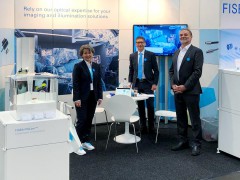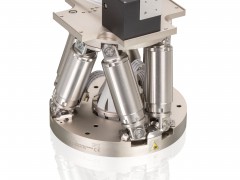
Colour-changing nanomaterials developed for roll-to-roll production
source:www.electrooptics.com/
keywords:
Time:2016-06-14

The research team has invented a way to make such sheets on an industrial scale, opening up applications ranging from smart clothing for people or buildings, to banknote security.
Using a new method called Bend-Induced-Oscillatory-Shearing (BIOS), the researchers are now able to produce hundreds of metres of these materials, known as ‘polymer opals’, on a roll-to-roll process. The results are reported in the journal Nature Communications.
based at Cambridge’s Cavendish Laboratory, the scientists have been working on methods of artificially recreating the colours produced by the systematically-ordered microstructures found in butterfly wings and beetles. To date, it has been difficult to make these materials using techniques that are cheap enough to allow their widespread use.
The team makes the polymer opals by growing vats of transparent plastic nano-spheres. The spheres are then dried out into a congealed mass, sandwiched between sheets and bent around successive rollers. The balls are forced into perfectly arranged stacks, by which stage they have intense colour.
By changing the sizes of the initial nano-spheres, different wavelengths of light are reflected. Since the material has a rubber-like consistency, when it is twisted and stretched, the spacing between the spheres changes, causing the material to change colour.
When stretched, the material shifts into the blue range of the spectrum, and when compressed, the colour shifts towards red. The material returns to its original colour when it is released. Such chameleon materials could find their way into colour-changing wallpapers, or building coatings that reflect infrared thermal radiation.
‘Finding a way to coax objects a billionth of a metre across into perfect formation over kilometre scales is a miracle,’ said Professor Jeremy Baumberg, the paper’s senior author. ‘But spheres are only the first step, as it should be applicable to more complex architectures on tiny scales.’
In order to make polymer opals in large quantities, the team first needed to understand their internal structure so that it could be replicated. Using a variety of techniques, including electron microscopy, x-ray scattering, rheology and optical spectroscopy, the researchers were able to see the three-dimensional position of the spheres within the material, measure how the spheres slide past each other, and how the colours change.
Cambridge Enterprise, the University’s commercialisation arm which is helping to commercialise the material, has been contacted by more than 100 companies interested in using polymer opals, and a new spin-out, Phomera Technologies, has been founded. Phomera will look at ways of scaling up production of polymer opals, as well as selling the material to potential buyers.
The company is considering applications such as coatings for buildings to reflect heat, smart clothing and footwear, or for banknote security and packaging applications.
Further Information
- RoboSense is to Produce the First Chinese Multi-beam LiDAR
- China is to Accelerate the Development of Laser Hardening Application
- Han’s Laser Buys Canadian Fiber Specialist CorActive
- SPI Lasers continues it expansion in China, appointing a dedicated Sales Director
- Laser Coating Removal Robot for Aircraft
 FISBA exhibits Customized Solutions for Minimally Invasive Medical Endoscopic Devices at COMPAMED in
FISBA exhibits Customized Solutions for Minimally Invasive Medical Endoscopic Devices at COMPAMED in New Active Alignment System for the Coupling of Photonic Structures to Fiber Arrays
New Active Alignment System for the Coupling of Photonic Structures to Fiber Arrays A new industrial compression module by Amplitude
A new industrial compression module by Amplitude Menhir Photonics Introduces the MENHIR-1550 The Industry's First Turnkey Femtosecond Laser of
Menhir Photonics Introduces the MENHIR-1550 The Industry's First Turnkey Femtosecond Laser of Shenzhen DNE Laser introduced new generation D-FAST cutting machine (12000 W)
more>>
Shenzhen DNE Laser introduced new generation D-FAST cutting machine (12000 W)
more>>
